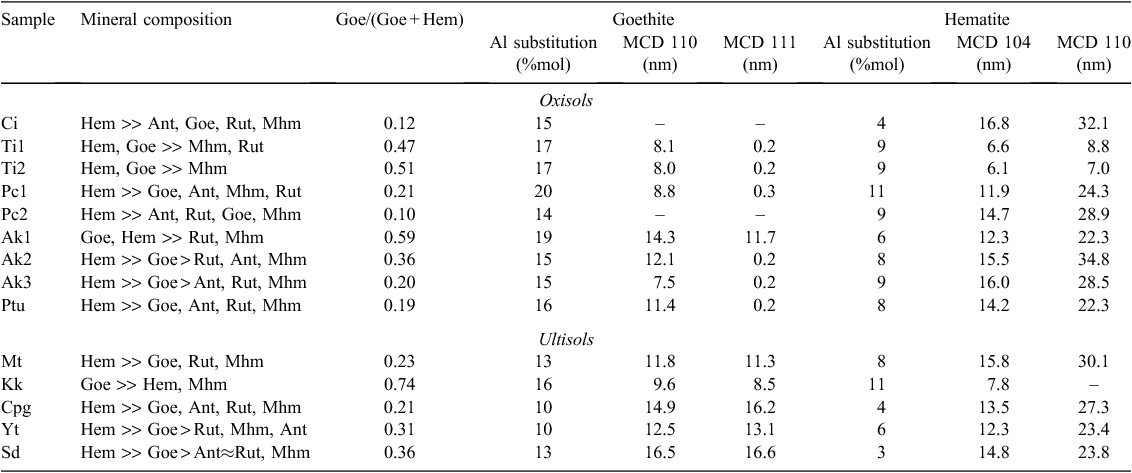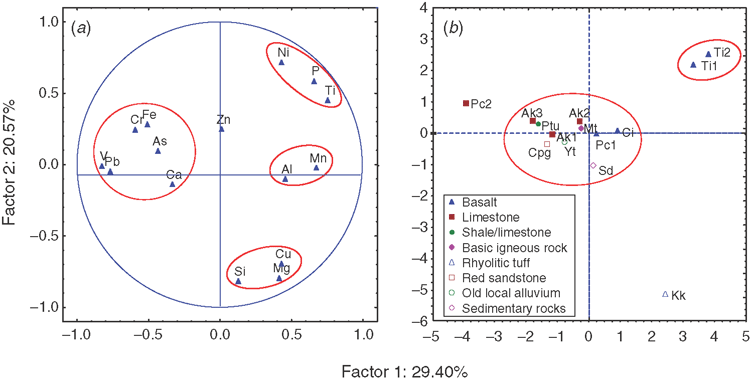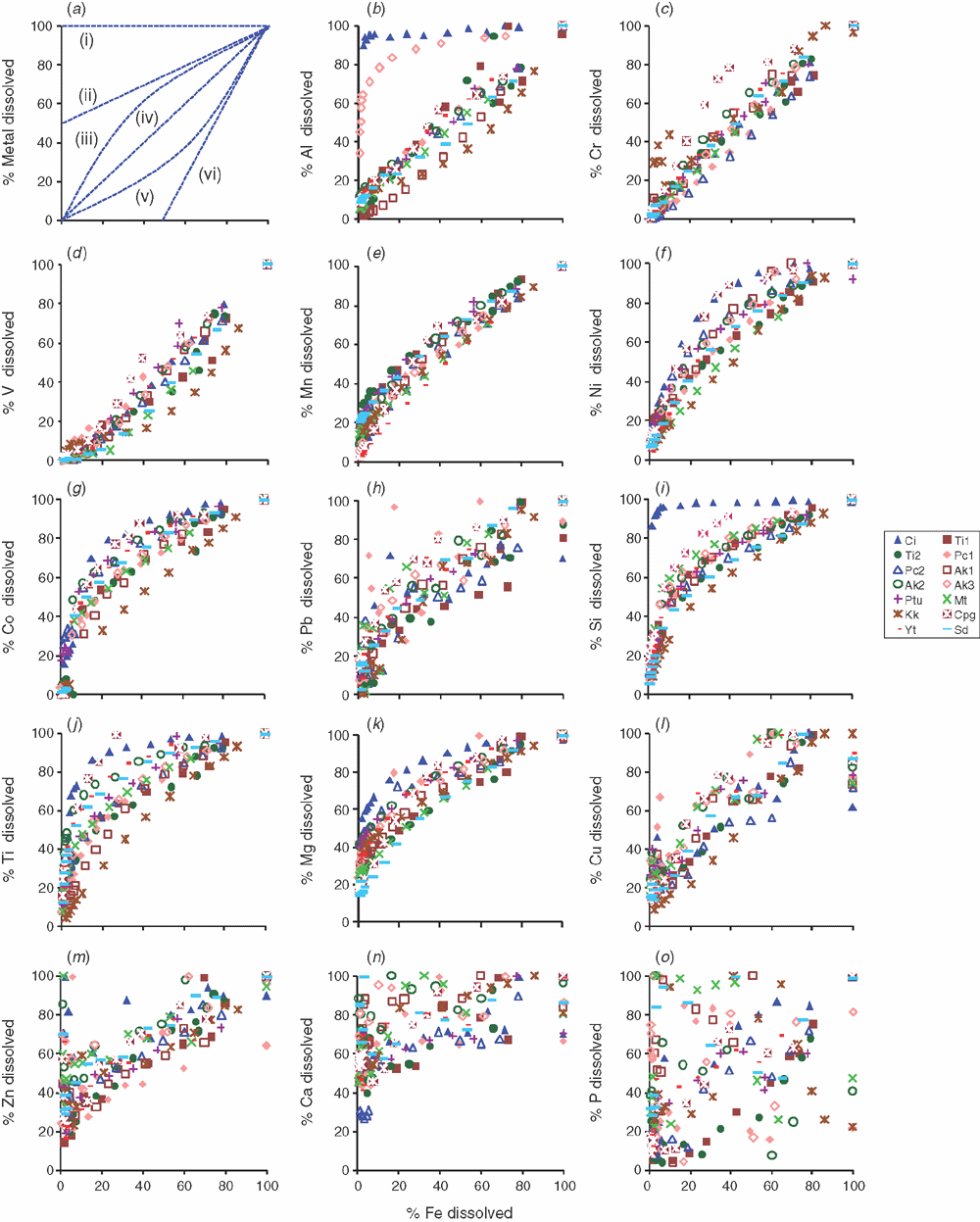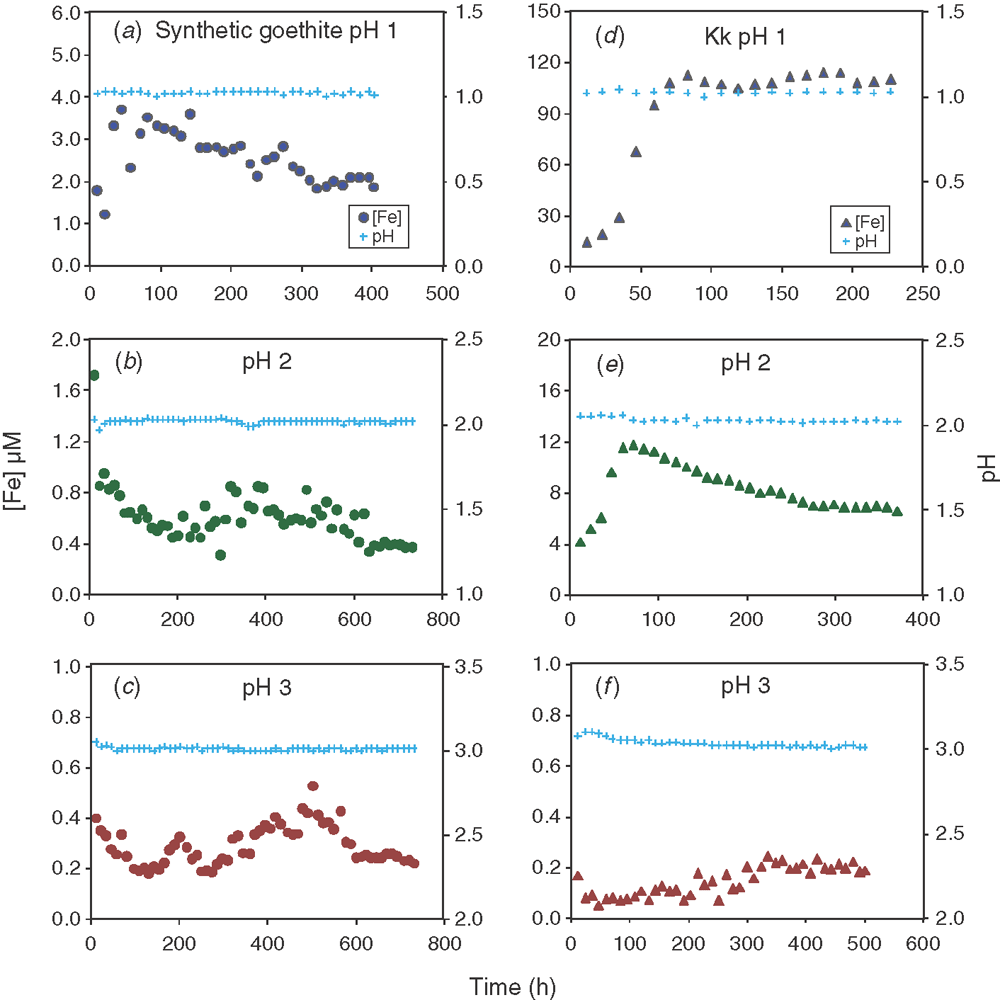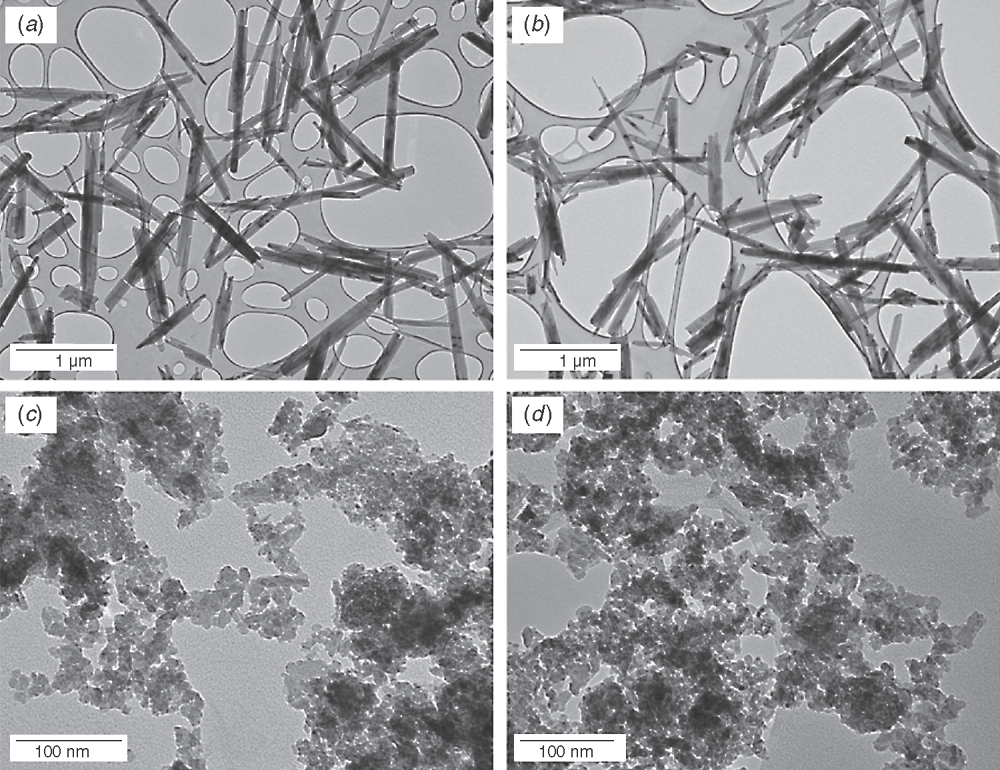Association of trace elements and dissolution rates of soil iron oxides
D. Ketrot A B , A. Suddhiprakarn A , I. Kheoruenromne A and B. Singh B CA Department of Soil Science, Faculty of Agriculture, Kasetsart University, Chatuchak, Bangkok 10900, Thailand.
B Faculty of Agriculture and Environment, University of Sydney, NSW 2006, Australia.
C Corresponding author. Email: balwant.singh@sydney.edu.au
Soil Research 52(1) 1-12 https://doi.org/10.1071/SR13092
Submitted: 21 March 2013 Accepted: 2 September 2013 Published: 5 February 2014
Abstract
In this study, nine Oxisols and five Ultisols from Thailand were used to determine the association of major and trace elements with iron (Fe) oxides. The Fe oxides were concentrated and the association of elements (Al, Ca, Cu, Cr, Mg, Mn, Ni, Pb, P, Si, V, Ti, Zn) with Fe was evaluated using batch dissolution in 1 m HCl at 20°C. The dissolution behaviour of Fe oxide concentrates was determined using batch dissolution and flow-through reactors. In addition to Fe, both Al and Ti were present in significant amounts in the Fe oxide concentrates. Manganese was the most abundant trace element, and Cu, Zn, Pb and As concentrations were <250 mg kg–1 in most samples. The dissolution behaviour of Fe-oxide concentrates indicated that Al, Cr and V were mostly substituted for Fe3+ in the structure of goethite and hematite. A significant proportion of Mn, Ni, Co, Pb and Si was also present within the structure of these minerals. Some Mg, Cu, Zn, Ti and Ca was also associated with Fe oxides. The dissolution kinetics of Fe oxide concentrates was well described by three models, i.e. the cube root law, Avrami–Erofejev equation and Kabai equation, with the dissolution rate constants (103k) corresponding to the three models ranging from 0.44 to 6.11 h–1, from 1.01 to 4.40 h–1 and from 0.03 to 4.12 h–1, respectively. The k constants of Fe oxide concentrates in this study were significantly and negatively correlated with the mean crystal dimension derived from [110] and [104] of hematite, the dominant mineral in most samples. The steady-state dissolution rate of a soil Fe-oxide concentrate (sample Kk) was substantially higher than for synthetic goethite under highly acidic conditions; this is possibly due to the greater specific surface area of sample Kk than the synthetic goethite.
Additional keywords: acid dissolution, batch method, Fe oxide concentrate, non-stirred flow through reactor method, total element concentration, tropical red soils.
Introduction
Iron (Fe) oxides are the most abundant metallic oxides in soils; they are present in various mineral forms depending upon present or past pedogenic conditions (Schwertmann and Taylor 1989). The distribution of Fe oxides in soils is also varied, ranging from a uniform distribution throughout the soil matrix to concentrated forms in segregations such as concretions and mottles (Schwertmann 1991; Singh and Gilkes 1992; Wiriyakitnateekul et al. 2007). Because of the variability of the chemical environment in soil during the precipitation of Fe oxides, and their ability to incorporate other trace elements into their structures, Fe oxides are an important source and sink of environmentally significant trace elements. Incorporation of several elements such as cadmium (Cd), cobalt (Co), chromium (Cr), copper (Cu), manganese (Mn), nickel (Ni), titanium (Ti), and zinc (Zn) occurs in the structure of synthetic goethites (Fitzpatrick et al. 1978; Lim-Nunez and Gilkes 1987; Singh et al. 2002; Cornell and Schwertmann 2003; Huynh et al. 2003; Kaur et al. 2009a, 2009b), which lends further support to the association of various trace elements with Fe oxides. Trace elements are commonly associated with Fe oxides in soils; however, it is not known whether these elements occur within a separate phase or substitute for Fe3+ in the structure of Fe oxides (Singh and Gilkes 1992; Trolard et al. 1995). The substitution of aluminium (Al) in soil goethite and hematite has been well established; however, the association of trace elements has received only limited attention (Fontes and Weed 1991; da Motta and Kämpf 1992; Singh and Gilkes 1992; Trakoonyingcharoen et al. 2006; Wiriyakitnateekul et al. 2007). Singh and Gilkes (1992) suggested that some portions of the Co, Cr, Cu, Mn, Ni and Zn, associated with Fe oxides in soils from south-western Australia, may be present within the structure of the two commonly occurring Fe oxides—goethite and hematite. A close association of trace elements, including Mn, Ni, Cr and vanadium (V), with Fe oxides exists in Thai soils (Wiriyakitnateekul et al. 2007). The nature of the association between trace elements and Fe oxides in soils has not been established for several other environmentally important trace elements.
Characterisation of the dissolution behaviour of natural Fe oxides containing several trace elements is important for predicting the availability of trace elements in soil environments. Dissolution studies of synthetic goethites have shown that factors such as the nature of the substituent metal, the extent of metal substitution, and the structural and morphological properties of minerals have a major control on their dissolution rate (Schwertmann 1991). Individual substitution of Al, Cr and Co into goethite structure decreases the dissolution rate of goethite in HCl (Schwertmann 1984; Lim-Nunez and Gilkes 1987; Ruan and Gilkes 1995). By contrast, the incorporation of Mn into goethite accelerated the dissolution rate compared with pure goethite (Lim-Nunez and Gilkes 1987; Schwertmann 1991; Alvarez et al. 2007). More recently, Kaur et al. (2010) found that the dissolution rate of single-metal-substituted goethite was in the order: Zn- > Pb(II)- ≥ Pb(IV)- > unsubstituted > Cd- > Cr-goethite. They observed complex dissolution behaviour for multi-metal-substituted goethite that was linearly related to steric strains determined from the lattice parameters of the mineral.
The objectives of this study were (i) to evaluate the association of several major and trace elements with Fe oxides in soils from Thailand using HCl dissolution kinetics and total element analysis, and (ii) to study the dissolution rate of soil Fe-oxide concentrates using a batch dissolution method and at the steady-state using flow-through reactors in highly acid solutions.
Materials and methods
Fe oxide concentrates and synthetic goethite
Soils from the B horizon of nine Oxisols and five Ultisols from Thailand were used for the study. The soils have developed on basalt, limestone, sandstone or alluvium. Soil descriptions and characteristics, site locations and land use are summarised in Table 1. The clay fraction of the soils was separated by repeated dispersion and sedimentation. Iron-oxide concentrates were obtained by boiling the clay fractions with 5 m NaOH to remove kaolinite and gibbsite (Singh and Gilkes 1991a).
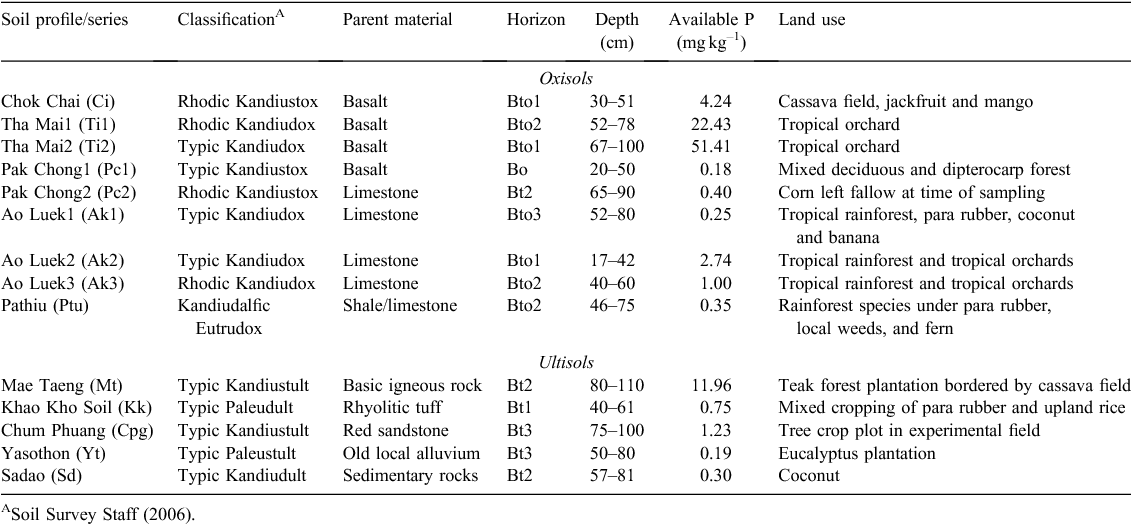
|
Random powder X-ray diffraction (XRD) patterns of Fe-oxide concentrates were obtained by scanning from 3 to 80° 2θ with a step size of 0.02° at 0.2° min–1 using Cu Kα radiation, λ = 1.5418 Å on a diffractometer (MMA, 35 kV and 28.5 mA; GBC Scientific Equipment Pty Ltd, Hampshire, IL, USA). The proportion of goethite to hematite (Goe/(Goe + Hem)) of Fe-oxide concentrate was estimated by a comparison of peak area of goethite (110) and hematite (104) in XRD patterns. Aluminium substitution was determined from the c-axis dimension of the goethite unit cell obtained from d(110) and d(111) and calculated using the relationship: mol% Al = 1730 – 572.0(c0) (Schulze 1984). For hematite, Al substitution was determined from the a-axis dimension of the hematite unit cell obtained from d(110) and calculated using the relationship: mol% Al = 3109 – 617.1a0 (Schwertmann et al. 1979). Mean crystallite dimension (MCD) of goethite and hematite were calculated from the width of reflections at half-maximum using the Scherrer formula (Klug and Alexander 1974).
Synthetic goethite used in this study was synthesised by rapidly adding 5 m KOH to 1 m Fe(NO3)3 solution while stirring, and ageing the precipitate for 2 weeks at 40°C (Schwertmann and Cornell 2000). This synthetic goethite was found by XRD to be pure goethite.
Total element analysis
The Fe-oxide concentrates and synthetic goethite were digested in concentrated HCl at 80°C until all Fe oxides dissolved; anatase and rutile were still present in the residues of the digests. The concentration of Fe, Al, Ca, Cu, Cr, Mg, Mn, Ni, lead (Pb), phosphorus (P), silicon (Si), V, Ti and Zn in the acid digests was determined using an inductively coupled plasma-atomic emission spectrometer (ICP-AES, Varian Vista AX CCD; Agilent Technologies, Santa Clara, CA, USA).
HCl dissolution kinetics of Fe-oxide concentrate
To determine the nature of the association of trace elements with Fe oxides, dissolution kinetics measurements were obtained by a batch dissolution method in acid solution. Briefly, 250 mg of Fe-oxide concentrate was added with 200 mL of 1 m HCl in a 250-mL plastic bottle, and the samples were shaken on a horizontal shaker (300 rpm) at 20 ± 1°C. After 1, 2, 3, 5, 7, 10, 20, 34, 48, 72, 96, 120, 144, 168 and 192 h, 5 mL of the suspension was withdrawn using an automatic pipette. The suspensions were immediately filtered through a 0.22-µm Millipore filter. The filtered solutions were analysed for Fe, Al, Ca, Co, Cu, Cr, Mg, Mn, Ni, Pb, P, Si, V, Ti and Zn using an ICP-AES.
Equations to describe the dissolution kinetics of Fe-oxide concentrates were cube-root law (Hixson and Crowell 1931), Avrami-Erofejev equation (Cornell and Giovanoli 1993) and Kabai equation (Kabai 1973). The cube root law is:

where W0 and W are the weight of sample at t = 0 and after time t, respectively, and k is a rate constant. The Avrami-Erofejev equation is:

where α is the fraction Fe dissolved at time t. The Kabai equation is:

where C0 and C are the amounts of Fe dissolved at t = 0 and at time t, respectively, and a is a phase-specific constant. A plot of ln[ln C0/(C0 – C)] against lnt results in a straight line from which k and a can be derived.
Dissolution rate of soil Fe oxides and synthetic goethite
Non-stirred flow-through reactors were used to evaluate the dissolution rate at the steady-state of a soil Fe oxide (sample Kk) and the synthetic goethite. The specific surface area (SSA) was measured by the BET N2 method (Aylmore et al. 1970), with values of 129 and 32 m2 g–1 for sample Kk and synthetic goethite, respectively. The flow-through reactor (46 mL in volume) used in this study has been described previously by Bibi et al. (2011). We used 100 mg Fe oxide for the dissolution experiment; the input solution was 0.01 m NaCl, which was prepared by using AR-grade NaCl, and solution pH was adjusted to the required value (1.0, 2.0 and 3.0) by adding AR-grade HCl. The flow rate of the input solution was 1.6 ± 0.2 mL h–1, which was maintained by a Gilson peristaltic pump. The reactors were immersed in a constant-temperature water bath at 25 ± 1°C. Output solution was collected after every 12 h, the solution pH was measured immediately using a calibrated pH meter (PHM 210 pH meter; Radiometer Analytical SAS, Villeurbanne, France), and the solution was stored at 5°C for Fe determination using ICP-AES (detection limit 0.01 mg L–1). The experiment was continued until the steady-state was reached, as indicated when the Fe in the output solution remained approximately constant (the difference of at least seven consecutive samples was <6%) (Bibi et al. 2011).
The dissolution rate (R) of Fe-oxide concentrates and synthetic goethite was calculated following equation below (Cervini-Silva and Sposito 2002; Cheah et al. 2003):

where [Fe] is the concentration of Fe in the output solution (µm) under steady-state conditions, q is the solution flow rate (L h–1), and m is the sample mass in the reactor (kg). The resulting units of R are then µmol kg–1 h–1.
The general reaction (protonation) between protons and goethite can be written as:

The speciation calculations were used to examine the extent of equilibration of the reaction in terms of the Gibbs free energy (ΔG) by using Eqn 6, which was modified from Bibi et al. (2011), but the resulting units of ΔG are kJ mol–1:

where SI is the saturation index of goethite and hematite, calculated using PHREEQC Version 2.18 (Parkhurst and Appelo 1999). The concentration of Fe (see Table 6) in the output solution at the steady-state was used in modelling with PHREEQC to calculate the SI value for the synthetic goethite and Kk samples.
The crystal morphology of both the synthetic goethite and the Kk sample was examined using transmission electron microscopy (TEM) before and after termination of the dissolution at the steady-state. A very dilute suspension of the samples was dispersed by an ultrasonic probe. A drop of suspension was deposited onto a carbon-coated grid and dried at room temperature. Micrographs were obtained using a JEOL 1400 electron microscope (JEOL Ltd, Tokyo).
Results and discussion
Mineralogical properties of Fe oxide concentrates
The mineralogical properties of Fe oxide concentrates are shown in Table 2. Hematite and goethite were the main constituents of Fe oxide concentrates from these Thai red soils (Trakoonyingcharoen et al. 2006; Wiriyakitnateekul et al. 2007). Maghemite, anatase and rutile were present in small amounts in most of the Fe oxide concentrates in the study. The Goe/(Goe + Hem) ratio ranged from 0.12 to 0.74. Most samples had a higher content of hematite than goethite, except for Ti1, Ti2 and Ak1, which had similar amounts of the two minerals. Sample Kk was the only sample where the goethite content exceeded the hematite content. Aluminium substitution in goethite ranged from 10 to 20 mol%, compared with 3–11 mol% Al in hematite in the samples. The substitution of Al in goethite was always greater than the corresponding value for hematite in the same sample. Similar observations were made in earlier studies on highly weathered Brazilian, Australian and Indonesian soils (Fontes and Weed 1991; da Motta and Kämpf 1992; Singh and Gilkes 1992; Prasetyo and Gilkes 1994). The MCD from XRD line-broadening indicated that goethite crystals had a smaller size than associated hematite, as is generally observed for tropical soils (Fontes and Weed 1991; Singh and Gilkes 1992; Prasetyo and Gilkes 1994; Muggler et al. 2001; Trakoonyingcharoen et al. 2006; Wiriyakitnateekul et al. 2007). Aluminium substitution in Fe oxides increases structural strain, slows the rate of crystal growth and reduces crystal size (Schwertmann 1988). Goethite from Ultisols showed similar crystal development along the three crystallographic axes (MCD110 : MCD111 close to 1 : 1). Higher values of MCD along [110] than [104] for hematite indicate better crystal development along X–Y axes compared with the Z-axis; this is indicative of the platy nature of hematite crystals (Fontes and Weed 1991).
Major and trace element concentrations in Fe-oxide concentrates and synthetic goethite
Total element concentrations in the Fe-oxide concentrates and synthetic goethite are presented in Table 3; however, some Ti did not dissolve and persisted as Ti oxides in residues. The concentration of Fe in the concentrates from soils ranged from 389 to 672 g kg–1, compared with 632 g kg–1 in the synthetic goethite. Samples Ci, Kk and Sd had lower Fe concentrations than the other samples, possible due to relatively large amounts of other minerals (Table 2) and the presence of residual alumino-silicate amorphous phase. Synthetic goethite had negligible to very low concentrations of other elements except Si and Ca, which resulted from the use of glassware in the synthesis. Aluminium and Ti were the major impurities in all Fe-oxide concentrates. Aluminium can be present as a structural substituent for Fe3+ in goethite and hematite, the two major Fe oxides in the Fe-oxide concentrates (Trakoonyingcharoen et al. 2006; Wiriyakitnateekul et al. 2007). With the exception of two samples (Ci and Ak3), Fe-oxide concentrates with high content of goethite also contained more Al (Tables 2 and 3), which is consistent with the greater Al substitution in goethite than hematite when they coexist. Aluminium in Ci and Ak3 samples originated from alumino-silcates and was not associated with Fe oxides. Titanium was mostly present in rutile and anatase, which did not fully dissolve in acid; however, some of the Ti can be in Fe oxides (Table 2). Other elements (Mn, Si, Ca, Mg, P, Cu, Zn, Ni, Cr, V, Pb and As) were commonly present in relatively smaller concentrations, with values ranging from below detection to 11 278 mg kg–1. Manganese was the most abundant among the other elements, with concentrations of 2396–11 278 mg kg–1, whereas the concentrations of Cu, Zn, Pb and As were generally low with values <250 mg kg–1 in the Fe-oxide concentrates. The high concentrations of Al, Si, Ca and Mg in some of the Fe oxide concentrates (e.g. sample Kk) are possibly due to an amorphous phase, composed mostly of Al and Si, precipitated during the dissolution of clay minerals while obtaining Fe-oxide concentrates; this phase could not be detected by XRD (Singh and Gilkes 1992). Samples Ti1 and Ti2 contained higher amounts of P than the other samples, which is reflected by their relatively high available-P values (Table 1). The Fe-oxide concentrates from soils derived from limestone and shale/limestone had relatively higher concentrations of V and As than the concentrates of soils derived from other parent materials. Darunsontaya et al. (2010) also reported high concentrations of V and As in soil clays derived from limestone; As was particularly high in the clay fraction of limestone-derived soils, with values ranging from 21 to 221 mg kg–1, values much larger than for soil clays derived from basalt, sedimentary rock and granite.
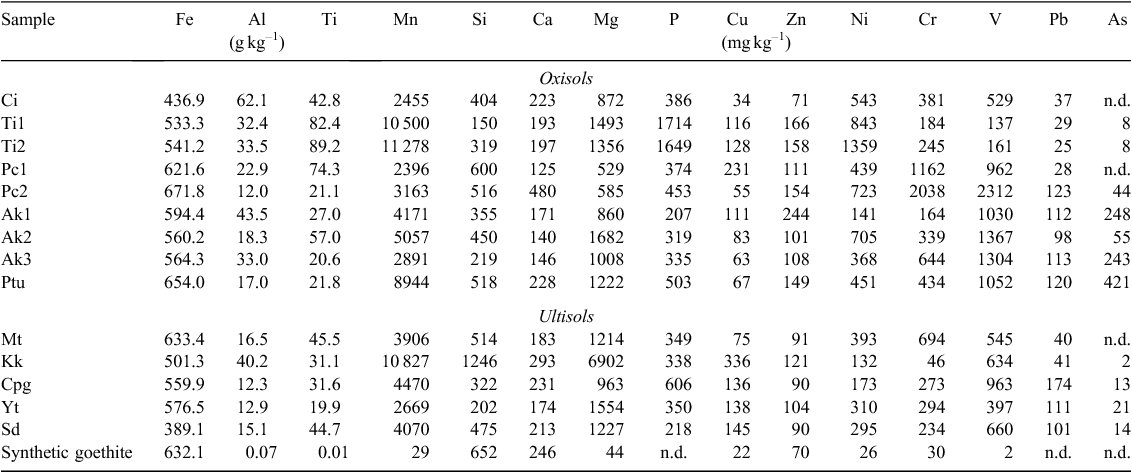
|
Principal component analysis of the total element concentration of Fe-oxide concentrates was used to identify elements and samples that have similar geochemical behaviour. Two factors could explain only ~50% of the variation in the data (Fig. 1a, b). These results are similar to those of Wiriyakitnateekul et al. (2007), in which first two factors explained only ~51% of the compositional variations for total element concentrations of Fe-oxide concentrates from Thai soils. They reported that most of the elements measured had a similar chemical behaviour and that Fe oxides in soils derived from basalt had quite different chemical composition from Fe oxides from other soils. However, for this study, the elements could be allocated into four groups, with Zn not belonging to any group (Fig. 1a). The first group included Fe, Cr, V, Pb, As and Ca. These elements had similar geochemical behaviour without systematic differences among soil parent materials. Nevertheless, sample Pc2 differed from other samples due to the high content of Fe-group elements (Fig. 1b). A second group included Si, Mg and Cu, and a third group included Al and Mn caused Kk to differ from other samples. The last group consisted of Ti, P and Ni; these elements were most abundant in samples Ti1 and Ti2, which formed a discrete group, with elevated P being due to fertiliser use.
Relationships between trace elements and soil Fe oxides based on HCl dissolution kinetics
Singh and Gilkes (1992) investigated the dissolution kinetics of Fe and trace elements in Fe-oxide concentrates, and based on the shape of the relationship between the proportions of Fe and metal dissolved, they suggested different mechanisms for the associated trace elements with Fe oxides in soils. They proposed that if an element was uniformly distributed throughout Fe-oxide crystals, Fe and the element will dissolve congruently, with a linear relationship and slope equal to 1 in plots of percentage metal v. percentage Fe dissolved, as indicated by line (iv) in Fig. 2a. If the element is present as a discrete phase that is very soluble, then 100% of the metal will dissolve before the dissolution of Fe commenced (line (i)). An initial rapid dissolution of a proportion (50%) of the element followed by congruent dissolution with Fe is indicated by line (ii). The converse scenario, where no dissolution of the element commences until 50% of Fe has dissolved, followed by congruent dissolution, is indicated by line (vi). The dissolution behaviour with trend lines similar to lines (ii) and (vi) are likely to indicate that at least 50% of the metal was not associated with Fe oxides. Intermediate behaviours for the association of elements and Fe are shown by the convex curve (iii) and concave curve (v).
The dissolution curves of Al, Cr and V (Fig. 2b, c, d, respectively) showed that for Fe-oxide concentrates, dissolution of these elements and Fe followed a pattern quite similar to the schematic dissolution line (iv) (congruent dissolution) with a few exceptions. For samples Ci and Ak3, Al dissolved faster than Fe (60–80% of Al released), similar to the schematic dissolution lines (i) and (ii), whereas for sample Cpg, Cr dissolved faster than Fe, similar to the schematic dissolution curve (iii). These results suggested that Al (in samples Ci and Ak3) and Cr (in sample Cpg) were present in a discrete phase or were adsorbed onto the surface of Fe-oxide particles, which was consistent with the total Al concentration that was mentioned before. The congruent dissolution of Al, Cr and V with Fe for the majority of samples suggests that these elements are in the structure of goethite and hematite. These metals are known to substitute for Fe3+ in the structures of goethite and hematite (Trolard et al. 1995; Manceau et al. 2000; Wells et al. 2001; Singh et al. 2002; Perrier et al. 2006). Aluminium substitution in hematite, the main Fe oxide, in sample Ci (Table 2) was very low but total Al was much higher than in the other samples (Table 3), which suggest that most of the Al in sample Ci was not present in the structure of Fe oxides.
Dissolution behaviour of Mn, Ni, Co, Pb and Si (Fig. 2e, f, g, h, i, respectively) were similar to the schematic dissolution curve (iii) and similar to the results reported for Mn, Ni and Co by Singh and Gilkes (1992). These results indicate that some proportion of Mn, Ni, Co, Pb and Si was present within the structure of Fe oxides. The initial greater release of these elements relative to Fe also suggests that some fraction of the element was present in a discrete solid or soluble phase or adsorbed on to Fe oxides. There are several reports indicating that these elements can be adsorbed by Fe oxides and/or incorporated into Fe-oxide structures (Quin et al. 1988; Angove et al. 1999; Christophi and Axe 2000; Manceau et al. 2000; Wells et al. 2006; Kaur et al. 2009a; Marcussen et al. 2009). The dissolution pattern for Ti was varied (Fig. 2j), showing similarity to schematic dissolution line (ii) and curve (iii). With only a small fraction of the total Ti in Fe-oxide concentrates dissolved during the experiment, we suspect that only a small proportion of Ti was associated with Fe oxides. Most of the Ti that was not dissolved existed in anatase and rutile. The initial faster release of Ti than Fe suggests that a small fraction of Ti was possibly present in nano-crystalline forms of Ti minerals or Ti adsorbed onto Fe oxides.
The dissolution behaviour of Mg, Cu, Zn and Ca (Fig. 2k, l, m, n, respectively) showed an intermediate pattern between lines (i) and (ii) and curve (iii). These results imply that at least 20% of Mg, Zn and Ca and 10% of Cu was not directly associated with Fe oxides. These elements were released during the Fe-oxide concentration process, by oxidation of organic carbon and dissolution of phyllosilicates, and then re-adsorbed onto Fe oxides. Phosphorus did not show any systematic relationship with Fe in the dissolution data (Fig. 2o). However, the greater release of P than Fe during the initial stage of dissolution indicates that some of the P was adsorbed on Fe-oxide surfaces. There are several reports indicating that Fe and Al oxides play a major role in controlling the availability of P in soils through the adsorption–desorption processes (Singh and Gilkes 1991b; Börling et al. 2001; Agbenin 2003; Trakoonyingcharoen et al. 2005; Wiriyakitnateekul et al. 2005; Wisawapipat et al. 2009).
Dissolution rate constant of soil Fe oxides based on HCl dissolution kinetics
The extent of Fe dissolution plotted against time is shown in Fig. 3. None of the samples was completely dissolved in 1 m HCl at 20°C within the 192-h dissolution period used in the study. The proportion of Fe dissolved at 192 h ranged from 0.07 to 0.42, except for Ti1 and Ti2, with values of 0.59 and 0.62, respectively. The dissolution data for the 14 Fe-oxide concentrates fitted very well to the equations for three models employed (Table 4). The dissolution rate constant (103k) ranged from 0.44 to 6.11 h–1 for the cube root law, from 1.01 to 4.40 h–1 for the Avrami-Erofejev equation and from 0.03 to 4.12 h–1, for the Kabai equation. These values are lower than values of 103k obtained at 40°C (1 m HCl) for 10 Fe-oxide concentrates from south-western Australia, with values ranging from 10.52 to 35.48 h–1 for the cube root law and from 7.56 to 32.16 h–1 for the Kabai equation (Singh and Gilkes 1992). The dissolution rate of goethite and hematite has been known to increase with increasing dissolution temperature, SSA and acid concentration (Chiarizia and Horwitz 1991; Cornell and Giovanoli 1993; Ruan and Gilkes 1995). The values of rate constants are also lower than values (64.8 to 3386.4 h–1) reported for the dissolution of six synthetic hematite in 2 m HCl at 65°C obtained using the Avrami-Erofejev equation (Cornell and Giovanoli 1993). Furthermore, values of 103k in this study are similar to values for synthetic goethite obtained by the first-order rate equation (ln(1 – α) = –kt) at 25°C with 2 m HCl (7.2 h–1), but lower than at 80°C with 1 m HCl (720 h–1) and 2 m HCl (4680 h–1) (Chiarizia and Horwitz 1991). Similarly, the dissolution rate constants observed in our study are comparable to the values obtained for goethite dissolution (3.96 × 103k h–1) and Al-goethite dissolution (3.42−3.96 × 103k h–1) in 1 m HCl at 30°C for the initial linear part of the graph described by the Kabai equation (Ruan and Gilkes 1995).
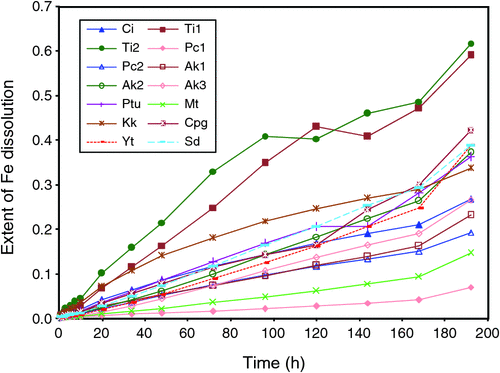
|
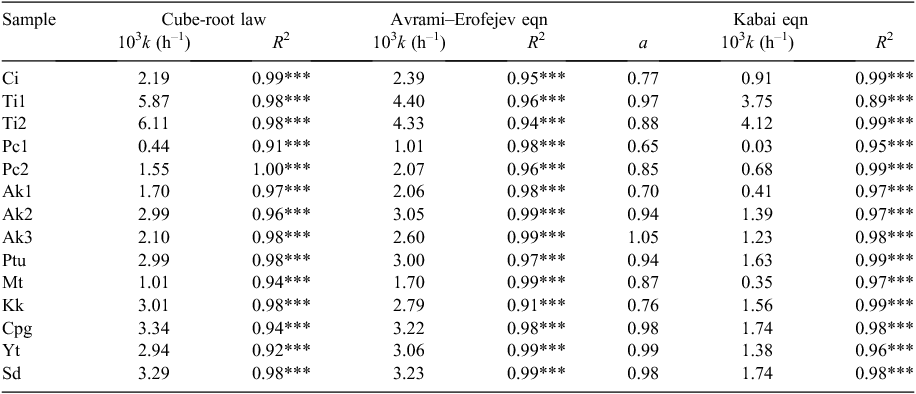
|
The MCD of hematite had significantly negative relationships with dissolution rate constants derived from the three equations. As hematite was the dominant mineral in most of the Fe-oxide concentrates, the crystal size of this mineral has a major influence on the dissolution rate of the Fe-oxide concentrates (Table 5). Several previous studies have shown an inverse relationship between crystal size (and SSA) and the dissolution rate of Fe oxides (Cornell and Giovanoli 1993; Wells et al. 2001). Furthermore, Ruan and Gilkes (1995) reported that the dissolution rate of synthetic goethite decreased with increasing Al substitution and increased with increasing dissolution temperature, SSA and heating temperature. Other properties of Fe-oxide concentrates including Goe/(Goe + Hem) ratio, Al substitution in both Fe oxides and MCD of goethite did not show any relationship with the dissolution rate constants (Table 5).
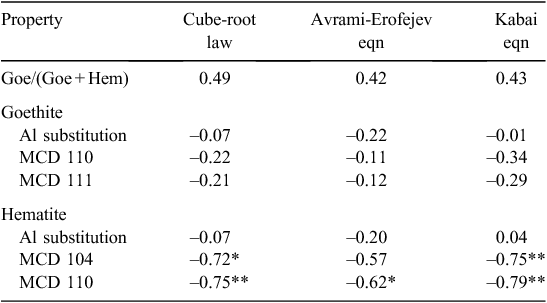
|
Dissolution rate of soil Fe oxides and synthetic goethite at the steady-state
The steady-state dissolution measurement takes several days and requires special equipment, and hence for this measurement, we used only two samples, a synthetic goethite and a goethite-rich soil Fe-oxide concentrate (sample Kk). The dissolution rate for the two samples was measured using non-stirred flow-through reactors and using 0.01 m NaCl as the electrolyte. The dissolution curve and dissolution rate of synthetic goethite and Kk samples are shown in Fig. 4 and Table 6, respectively. Dissolution of synthetic goethite at pH 1.0 plotted against time (Fig. 4a) showed that the rate of Fe release was rapid during the initial period (up to 83 h) and then decreased before reaching the steady-state (~336 h). Iron release from synthetic goethite was generally low at pH 2.0 and 3.0 (Fig. 4b, c, respectively). The Fe concentration declining with time at pH 1.0 and 2.0 showed no systematic trend at pH 3.0. Little Fe was released rapidly at pH 1.0 from sample Kk (Fig. 4d), but by 80 h a constant rate of dissolution occurred. A similar trend occurred for pH 2.0 (Fig. 4e); however, the steady-state at this pH was reached later (after 288 h) than at pH 1.0. At pH 3.0 (Fig. 4f), Fe release from sample Kk was very low (close to detection limit 0.01 mg L–1 of ICP-AES) and it increased slowly to reach a steady-state at ~372 h.
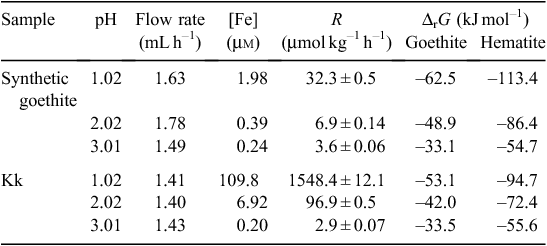
|
The dissolution rate of both the synthetic goethite and Kk samples followed a decreasing trend with solution pH, with the maximum dissolution rate observed at pH 1.0 and the lowest rate at pH 3.0 (Table 6). The dissolution rate of both Fe oxides decreased linearly with increasing solution pH from 1.0 to 3.0 (Fig. 5); however, the effect was more pronounced for sample Kk than the synthetic goethite. The dissolution rate of sample Kk was much greater than the synthetic goethite at pH 1.0 and 2.0, but at pH 3.0 the dissolution rate was similar for the two samples. The much higher dissolution rate of sample Kk than the synthetic goethite at pH 1.0 and 2.0 was possibly due in part to the higher SSA of sample Kk (129 m2 g–1) than the synthetic goethite (32 m2 g–1) (Cornell and Giovanoli 1993; Wells et al. 2001). Structural disorder in sample Kk, possibly resulting from the substitution of multiple elements (other than Al), may also have contributed to the higher dissolution rate of this sample compared with the synthetic goethite (Fig. 2). Individual substitutions of foreign elements in the goethite structure are known to produce different effects on the dissolution of the mineral. For example, the substitution of Mn, Co, Pb and Zn in goethite is known to increase its dissolution rate (Alvarez et al. 2005, 2008; Kaur et al. 2010), whereas the substitution of Al, Cr and Cd decreased the dissolution rate of goethite (Alvarez et al. 2007; Kaur et al. 2010). However, the presence of Zn, Pb and Cd in di- and tri-metal (Zn-Pb, Zn-Cd and Zn-Pb-Cd) incorporated goethite increased the dissolution rate of goethite (Kaur et al. 2010). The dissolution rates of the synthetic goethite and Kk samples at pH 3.0 in this study were close to the dissolution rates of goethite at pH 5.0 in the presence of 200 µm oxalate (dissolution rate was 3.3 µmol kg–1 h–1) reported by Cheah et al. (2003).
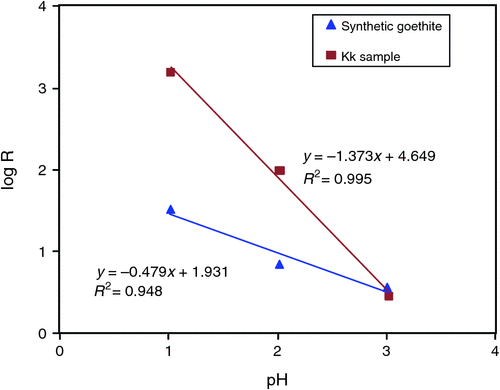
|
The approximate steady-state dissolution of the synthetic goethite and Kk samples in this study showed under-saturation with respect to goethite and hematite, with ΔrG <0 (Table 6). The ΔrG for both the synthetic goethite and Kk samples increased with increasing pH. The ΔrG value of synthetic goethite at pH 1.0 and 2.0 was slightly lower than that for Kk, and was very similar at pH 3.0. The ΔrG values of the sample in this study were lower than the ΔrG for goethite dissolution reported by Cheah et al. (2003) for various pH values.
As shown by transmission electron micrographs, the crystals of original synthetic goethite were acicular, with particle sizes ranging from around 0.5 to 2 µm (Fig. 6a). For sample Kk, the crystals had a flat, rounded morphology and small size (<20 nm) (Fig. 6c), which is consistent with MCD110 and MCD111 values of goethite in Table 2. The small crystal size of sample Kk corresponds to higher SSA than for synthetic goethite. There was no observable difference in the crystal size and shape before and after steady-state dissolution was reached at pH 1.0 for either the synthetic goethite (Fig. 6a, b) or Kk (Fig. 6c, d) samples. Although only a small proportion of the samples was dissolved, nevertheless these observations suggest that there was no selective dissolution along a particular crystal axis of the synthetic and natural samples. Schwertmann (1984) reported that both sides of the lath are attacked by protons, and rounded corrosion features are formed for Al-goethite, but unsubstituted Al-goethite showed preferential dissolution between domains and showed formation of a rhombic holes feature. Furthermore, Cornell and Giovanoli (1993) reported that all crystal faces of hematite dissolved equally well except where susceptible regions were present, and some preferential attack took place at the (001) faces of the platy crystal, leading to hole formation. Similarly, rounded hematite in soil from south-eastern Ohio (Washington county; 39°28′00″N, 81°33′30″W) exhibited dissolution cavities attributable to instability within the modern pedo-environment (Bigham et al. 1991).
Summary and conclusions
Hematite and goethite are abundant Fe oxides in the Oxisols and Ultisols from Thailand examined in this study. Hematite was the dominant Fe oxide in most of the Fe-oxide concentrates of these soils. Iron, Al and Ti were present in significant quantities in the Fe-oxide concentrates. Manganese was the most abundant trace element in the Fe-oxide concentrates. Near-congruency of dissolution indicates that Al, Cr and V are substituted in goethite and hematite structures of most samples. Much of the Mn, Ni, Co, Pb, Si and Ti also appeared to present within the structure of these minerals, whereas Mg, Cu, Zn and Ca were closely associated with Fe oxides but perhaps not substituted in the minerals.
Dissolution behaviour of Fe-oxide concentrates in 1 m HCl at 20°C was well described by the three models investigated. The dissolution rate constant (103k) values obtained using the three models are lower value than many reported values in the literature, due to the lower concentration of the acid and lower temperature used in our study. The dissolution constants were inversely related to the MCD along [110] and [104] of hematite, the dominant mineral in the Fe-oxide concentrates. The near steady-state dissolution rate of the soil Fe-oxide concentrate (Kk) was much higher than that of the synthetic goethite at pH 1.0 and 2.0; however, at pH 3.0 their dissolution rates were similar. The difference could be partly attributed to the higher SSA of sample Kk than the synthetic goethite. These results may have consequences on the availability of several elements including essential and toxic elements.
The results of this study substantiate the early data obtained for Fe-oxide concentrates for Australian and Thai soils (Singh and Gilkes 1992; Wiriyakitnateekul et al. 2007). The results of this study identified that in addition to Al, Cr, Ni, Mn and V, some other elements including Co, Cu and Pb may be associated with Fe oxides in highly weathered soils. Structural incorporation of small (except for Al) and variable amounts of these elements produces structural disorder resulting in much smaller crystal size of goethite and hematite. Our results suggest that Fe oxides isolated from highly weathered soils dissolved at a much faster rate than pure synthetic goethite under highly acidic conditions.
Acknowledgements
The authors are grateful to The Royal Golden Jubilee PhD Program under The Thailand Research Fund, Kasetsart University and Kasetsart University Research and Development Institute (KURDI) for financial support and to the Faculty of Agriculture and Environment, The University of Sydney, for some laboratory facilities and for staff cooperation and assistance. The authors gratefully acknowledge Dr Nattaporn Prakongkept for the SSA analysis, and Waqar Ahmad and Tom Savage for their help in the total elemental analysis of Fe-oxide concentrates. The authors also acknowledge the facilities as well as scientific and technical assistance from staff in the AMMRF (Australian Microscopy and Microanalysis Research Facility) at the Electron Microscope Unit, The University of Sydney. We thank Bob Gilkes for his critical comments on an earlier version of the manuscript.
References
Agbenin JO (2003) Extractable iron and aluminum effects on phosphate sorption in a savanna Alfisols. Soil Science Society of America Journal 67, 589–595.| Extractable iron and aluminum effects on phosphate sorption in a savanna Alfisols.Crossref | GoogleScholarGoogle Scholar | 1:CAS:528:DC%2BD3sXkslChsbo%3D&md5=0a8efe23c1beec2c76a58cbca6b04366CAS |
Alvarez M, Sileo EE, Rueda EH (2005) Effect of Mn(II) incorporation on the transformation of ferrihydrite to goethite. Chemical Geology 216, 89–97.
| Effect of Mn(II) incorporation on the transformation of ferrihydrite to goethite.Crossref | GoogleScholarGoogle Scholar | 1:CAS:528:DC%2BD2MXhs1GntLY%3D&md5=bccaf65bc4a742bfa9ff39bd8e0cca03CAS |
Alvarez M, Rueda EH, Sileo EE (2007) Simultaneous incorporation of Mn and Al in the goethite structure. Geochimica et Cosmochimica Acta 71, 1009–1020.
| Simultaneous incorporation of Mn and Al in the goethite structure.Crossref | GoogleScholarGoogle Scholar | 1:CAS:528:DC%2BD2sXht1Gltrg%3D&md5=4e018649ba32e483024901d5716b81dcCAS |
Alvarez M, Sileo EE, Rueda EH (2008) Structure and reactivity of synthetic Co-substituted goethites. The American Mineralogist 93, 584–590.
| Structure and reactivity of synthetic Co-substituted goethites.Crossref | GoogleScholarGoogle Scholar | 1:CAS:528:DC%2BD1cXksVKjsbo%3D&md5=562c4ffd928006e3ef20082ab77368c8CAS |
Angove MJ, Wells JD, Johnson BB (1999) The influence of temperature on the adsorption of cadmium(II) and cobalt(II) on goethite. Journal of Colloid and Interface Science 211, 281–290.
| The influence of temperature on the adsorption of cadmium(II) and cobalt(II) on goethite.Crossref | GoogleScholarGoogle Scholar | 1:CAS:528:DyaK1MXhtlCisrk%3D&md5=ede2992c6f468c7d972bc36940adc98aCAS | 10049544PubMed |
Aylmore LAG, Sills ID, Quirk JP (1970) Surface area of homoionic illite and montmorillonite clay mineral as measured by the sorption of nitrogen and carbon dioxide. Clays and Clay Minerals 18, 91–96.
| Surface area of homoionic illite and montmorillonite clay mineral as measured by the sorption of nitrogen and carbon dioxide.Crossref | GoogleScholarGoogle Scholar | 1:CAS:528:DyaE3cXlt1ert7w%3D&md5=2bdfb6702f698ef96c130182d75f6254CAS |
Bibi I, Singh B, Silvester E (2011) Dissolution of illite in saline-acidic solutions at 25°C. Geochimica et Cosmochimica Acta 75, 3237–3249.
| Dissolution of illite in saline-acidic solutions at 25°C.Crossref | GoogleScholarGoogle Scholar | 1:CAS:528:DC%2BC3MXltlyktLw%3D&md5=e745ec23dad0f305f319a713a817e85cCAS |
Bigham JM, Heckendorn SE, Jaynes WF, Smeck NE (1991) Stability of iron oxides in two soils with contrasting colors. Soil Science Society of America Journal 55, 1485–1492.
| Stability of iron oxides in two soils with contrasting colors.Crossref | GoogleScholarGoogle Scholar | 1:CAS:528:DyaK38Xmtlyjuw%3D%3D&md5=1f6f2721519b65020e82dfd0f44af9b0CAS |
Börling K, Otabbong E, Barberis E (2001) Phosphorus sorption in relation to soil properties in some cultivated Swedish soils. Nutrient Cycling in Agroecosystems 59, 39–46.
| Phosphorus sorption in relation to soil properties in some cultivated Swedish soils.Crossref | GoogleScholarGoogle Scholar |
Cervini-Silva J, Sposito G (2002) Steady-state dissolution kinetics of aluminum-goethite in the presence of desferrioxamine-B and oxalate ligands. Environmental Science & Technology 36, 337–342.
| Steady-state dissolution kinetics of aluminum-goethite in the presence of desferrioxamine-B and oxalate ligands.Crossref | GoogleScholarGoogle Scholar | 1:CAS:528:DC%2BD38XhtFantw%3D%3D&md5=2ce92b7fe4e1a2a6d7705ca8f8f17b16CAS |
Cheah SF, Kraemer SM, Cervini-Silva J, Sposito G (2003) Steady-state dissolution kinetics of goethite in the presence of desferrioxamine B and oxalate ligands: implications for the microbial acquisition of iron. Chemical Geology 198, 63–75.
| Steady-state dissolution kinetics of goethite in the presence of desferrioxamine B and oxalate ligands: implications for the microbial acquisition of iron.Crossref | GoogleScholarGoogle Scholar | 1:CAS:528:DC%2BD3sXjt1elsLk%3D&md5=61140338af75daf59f32233e0da1ec1dCAS |
Chiarizia R, Horwitz EP (1991) New formulations for iron oxides dissolution. Hydrometallurgy 27, 339–360.
| New formulations for iron oxides dissolution.Crossref | GoogleScholarGoogle Scholar | 1:CAS:528:DyaK38Xpt1ertQ%3D%3D&md5=ef28671a674f69935cdf01f981fa2254CAS |
Christophi CA, Axe L (2000) Competition of Cd, Cu, and Pb adsorption on goethite. Journal of Environmental Engineering 126, 66–74.
| Competition of Cd, Cu, and Pb adsorption on goethite.Crossref | GoogleScholarGoogle Scholar | 1:CAS:528:DyaK1MXotFartLY%3D&md5=b66147d9ada6a464506882a6b59fd036CAS |
Cornell RM, Giovanoli R (1993) Acid dissolution of hematites of different morphologies. Clay Minerals 28, 223–232.
| Acid dissolution of hematites of different morphologies.Crossref | GoogleScholarGoogle Scholar | 1:CAS:528:DyaK3sXmsFektro%3D&md5=70ccbf8e7e02da3c871eda2494534c74CAS |
Cornell RM, Schwertmann U (2003) ‘The iron oxides: structure, properties, reactions, occurrences and uses.’ 2nd edn (Wiley-VCH Verlag GmbH & Co., KGaA: Weinheim, Germany)
da Motta PEF, Kämpf N (1992) Iron oxide properties as support to soil morphological features for prediction of moisture regimes in Oxisols of Central Brazil. Journal of Plant Nutrition and Soil Science 155, 385–390.
| Iron oxide properties as support to soil morphological features for prediction of moisture regimes in Oxisols of Central Brazil.Crossref | GoogleScholarGoogle Scholar | 1:CAS:528:DyaK3sXkt1Grsg%3D%3D&md5=92968276f5236cbda5d27cb0a252ae6dCAS |
Darunsontaya T, Suddhiprakarn A, Kheoruenromne I, Gilkes RJ (2010) Geochemical properties and the nature of kaolin and iron oxides in upland Oxisols and Ultisols under a tropical monsoonal climate, Thailand. Thai Journal of Agricultural Science 43, 197–215.
Fitzpatrick RW, Roux JL, Schwertmann U (1978) Amorphous and crystalline titanium and iron-titanium oxides in synthetic preparations, at near ambient conditions, and in soil clays. Clays and Clay Minerals 26, 189–201.
| Amorphous and crystalline titanium and iron-titanium oxides in synthetic preparations, at near ambient conditions, and in soil clays.Crossref | GoogleScholarGoogle Scholar | 1:CAS:528:DyaE1MXis1GjsA%3D%3D&md5=0821de5b6dac5ec11c6b8d712767af67CAS |
Fontes MPF, Weed SB (1991) Iron oxides in selected Brazilian Oxisols: I. Mineralogy. Soil Science Society of America Journal 55, 1143–1149.
| Iron oxides in selected Brazilian Oxisols: I. Mineralogy.Crossref | GoogleScholarGoogle Scholar | 1:CAS:528:DyaK3MXlsFOqsLg%3D&md5=105c5ba5c3695a79feb06e9750805732CAS |
Hixson AW, Crowell JH (1931) Dependence of reaction velocity upon surface and agitation. I. Theoretical consideration. Industrial & Engineering Chemistry 23, 923–931.
| Dependence of reaction velocity upon surface and agitation. I. Theoretical consideration.Crossref | GoogleScholarGoogle Scholar | 1:CAS:528:DyaA3MXksV2rtw%3D%3D&md5=acf128485dba900280e25394e390e55eCAS |
Huynh T, Tong AR, Singh B, Kennedy BJ (2003) Cd substituted goethites-a structural investigation by synchrotron X-ray diffraction. Clays and Clay Minerals 51, 397–402.
| Cd substituted goethites-a structural investigation by synchrotron X-ray diffraction.Crossref | GoogleScholarGoogle Scholar | 1:CAS:528:DC%2BD3sXmsVajsbg%3D&md5=20ec3fdee602a1df7749ac20893471afCAS |
Kabai J (1973) Determination of specific activation energies of metal oxides and metal oxide hydrates by measurement of the rate of dissolution. Acta Chimica Academiae Scientiarum Hungaricae 78, 57–73.
Kaur N, Gräfe M, Singh B, Kennedy BJ (2009a) Simultaneous incorporation of Cr, Zn, Cd, and Pb in the goethite structure. Clays and Clay Minerals 57, 234–250.
| Simultaneous incorporation of Cr, Zn, Cd, and Pb in the goethite structure.Crossref | GoogleScholarGoogle Scholar | 1:CAS:528:DC%2BD1MXnslSms7Y%3D&md5=ac2d26240fa7cc968e01c7cb228c480eCAS |
Kaur N, Singh B, Kennedy BJ (2009b) Copper substitution alone and in the presence of chromium, zinc, cadmium and lead in goethite (α-FeOOH). Clay Minerals 44, 293–310.
| Copper substitution alone and in the presence of chromium, zinc, cadmium and lead in goethite (α-FeOOH).Crossref | GoogleScholarGoogle Scholar | 1:CAS:528:DC%2BD1MXhsFOgsLbM&md5=de3a7e2255211293590119b0c1597f23CAS |
Kaur N, Singh B, Kennedy BJ (2010) Dissolution of Cr, Zn, Cd, and Pb single- and multi-metal-substituted goethite: Relationship to structural, morphological, and dehydroxylation properties. Clays and Clay Minerals 58, 415–430.
| Dissolution of Cr, Zn, Cd, and Pb single- and multi-metal-substituted goethite: Relationship to structural, morphological, and dehydroxylation properties.Crossref | GoogleScholarGoogle Scholar | 1:CAS:528:DC%2BC3cXhtFyhu77L&md5=8f59d3e9c59ae0d238d6ea00d4f3dd92CAS |
Klug HP, Alexander LE (1974) ‘X-ray diffraction procedures for polycrystalline and amorphous materials.’ (John Wiley: New York)
Lim-Nunez R, Gilkes RJ (1987) Acid dissolution of synthetic metal-containing goethites and hematites. In ‘Proceedings of the International Clay Conference’. Denver, USA 1985. (Eds LG Schultz, H van Olphen, FA Mumpton) pp. 197–204. (The Clay Mineral Society: Bloomington, IN)
Manceau A, Schlegel ML, Musso M, Sole VA, Gauthier C, Petit PE, Trolard F (2000) Crystal chemistry of trace elements in natural and synthetic goethite. Geochimica et Cosmochimica Acta 64, 3643–3661.
| Crystal chemistry of trace elements in natural and synthetic goethite.Crossref | GoogleScholarGoogle Scholar | 1:CAS:528:DC%2BD3cXnsFWhurY%3D&md5=33c7eba74e6162df377182cbf62ad588CAS |
Marcussen H, Holm PE, Strobel BW, Hansen HC (2009) Nickel sorption to goethite and montmorillonite in presence of citrate. Environmental Science & Technology 43, 1122–1127.
| Nickel sorption to goethite and montmorillonite in presence of citrate.Crossref | GoogleScholarGoogle Scholar | 1:CAS:528:DC%2BD1MXhtVaqtrk%3D&md5=7f0e5883d6f5f0ee36a9d4f224745d9dCAS |
Muggler CC, Van Loef JJ, Buurman P, van Doesburg JDJ (2001) Mineralogical and (sub) microscopic aspects of iron oxides in polygenetic Oxisols from Minas Gerais, Brazil. Geoderma 100, 147–171.
| Mineralogical and (sub) microscopic aspects of iron oxides in polygenetic Oxisols from Minas Gerais, Brazil.Crossref | GoogleScholarGoogle Scholar | 1:CAS:528:DC%2BD3MXpsVGhtQ%3D%3D&md5=17246e649a1420d6d785b7684ef25625CAS |
Parkhurst DL, Appelo CAJ (1999) ‘User’s guide to PHREEQC (version 2)—a computer program for speciation, batch reaction, one-dimensional transport, and inverse geochemical calculations.’ Water-Resources Investigations Report No. 99-4259. (U.S. Geological Survey: Reston, VA)
Perrier N, Gilkes RJ, Colin F (2006) Heating Fe oxide-rich soils increases the dissolution rate of metals. Clays and Clay Minerals 54, 165–175.
| Heating Fe oxide-rich soils increases the dissolution rate of metals.Crossref | GoogleScholarGoogle Scholar | 1:CAS:528:DC%2BD28Xkslygsb0%3D&md5=7176038a199492d0166aca76a35f3992CAS |
Prasetyo BH, Gilkes RJ (1994) Properties of iron oxides from red soils derived from volcanic tuff in west Java. Australian Journal of Soil Research 32, 781–794.
| Properties of iron oxides from red soils derived from volcanic tuff in west Java.Crossref | GoogleScholarGoogle Scholar | 1:CAS:528:DyaK2cXmtVCit7k%3D&md5=3c839935a9238219ee75ed00c252db1dCAS |
Quin TG, Long GJ, Benson CG, Mann S, Williams RJP (1988) Influence of silicon and phosphorus on structural and magnetic properties of synthetic goethite and related oxides. Clays and Clay Minerals 36, 165–175.
| Influence of silicon and phosphorus on structural and magnetic properties of synthetic goethite and related oxides.Crossref | GoogleScholarGoogle Scholar | 1:CAS:528:DyaL1cXitVOrs70%3D&md5=c26576d428282bade0ff6f73a8705061CAS |
Ruan HD, Gilkes RJ (1995) Acid dissolution of synthetic aluminous goethite before and after transformation to hematite by heating. Clay Minerals 30, 55–65.
| Acid dissolution of synthetic aluminous goethite before and after transformation to hematite by heating.Crossref | GoogleScholarGoogle Scholar | 1:CAS:528:DyaK2MXltVCjsbc%3D&md5=bddcc3d7a9689704de980bd85003e009CAS |
Schulze DG (1984) The influence of aluminum on iron oxides. VIII. Unit-cell dimensions of Al-substituted goethites and estimation of Al from them. Clays and Clay Minerals 32, 36–44.
| The influence of aluminum on iron oxides. VIII. Unit-cell dimensions of Al-substituted goethites and estimation of Al from them.Crossref | GoogleScholarGoogle Scholar | 1:CAS:528:DyaL2cXovV2huw%3D%3D&md5=d014d1c1efdd62c0aade842050a8e188CAS |
Schwertmann U (1984) The influence of aluminium on iron oxides; IX. Dissolution of Al-goethites in 6M HCl. Clay Minerals 19, 9–19.
| The influence of aluminium on iron oxides; IX. Dissolution of Al-goethites in 6M HCl.Crossref | GoogleScholarGoogle Scholar | 1:CAS:528:DyaL2cXksVWitbk%3D&md5=e5f982a26ed6efd40ac3d27ebef2d36eCAS |
Schwertmann U (1988) Goethite and hematite formation in the presence of clay minerals and gibbsite at 25°C. Soil Science Society of America Journal 52, 288–291.
| Goethite and hematite formation in the presence of clay minerals and gibbsite at 25°C.Crossref | GoogleScholarGoogle Scholar | 1:CAS:528:DyaL1cXhvFShs7o%3D&md5=33c9882e41984215a0a6e265c65f488fCAS |
Schwertmann U (1991) Solubility and dissolution of iron oxides. Plant and Soil 130, 1–25.
| Solubility and dissolution of iron oxides.Crossref | GoogleScholarGoogle Scholar | 1:CAS:528:DyaK3MXhsVajtbo%3D&md5=b453ee69e4eb87f01c66398132c75f62CAS |
Schwertmann U, Cornell RM (2000) ‘Iron oxides in the laboratory: preparation and characterization.’ 2nd edn (Wiley-VCH Verlag GmbH: Weinheim, Germany)
Schwertmann U, Taylor RM (1989) Iron oxides. In ‘Minerals in soil environments’. (Eds JB Dixon, SB Weed) pp. 379–438, (Soil Science Society of America: Madison, WI)
Schwertmann U, Fitzpatrick RW, Taylor RM, Lewis DG (1979) The influence of aluminum on iron oxides. Part II. Preparation and properties of Al-substituted hematites. Clays and Clay Minerals 27, 105–112.
| The influence of aluminum on iron oxides. Part II. Preparation and properties of Al-substituted hematites.Crossref | GoogleScholarGoogle Scholar | 1:CAS:528:DyaE1MXitVOgsbg%3D&md5=da99db79ee19e1ef30f94fab38acc22fCAS |
Singh B, Gilkes RJ (1991a) Concentration of iron oxides from soil clays by 5M NaOH treatment: the complete removal of sodalite and kaolin. Clay Minerals 26, 463–472.
| Concentration of iron oxides from soil clays by 5M NaOH treatment: the complete removal of sodalite and kaolin.Crossref | GoogleScholarGoogle Scholar | 1:CAS:528:DyaK38XhsVartLc%3D&md5=44e66677f21931962c02244852137673CAS |
Singh B, Gilkes RJ (1991b) Phosphorus sorption in relation to soil properties for the major soils types of South–Western Australia. Australian Journal of Soil Research 29, 603–618.
| Phosphorus sorption in relation to soil properties for the major soils types of South–Western Australia.Crossref | GoogleScholarGoogle Scholar | 1:CAS:528:DyaK3MXmslyrsrk%3D&md5=0b79fae6e0235a905a1daadee10b3b78CAS |
Singh B, Gilkes RJ (1992) Properties and distribution of iron oxides and their association with minor elements in the soils of south-western Australia. Journal of Soil Science 43, 77–98.
| Properties and distribution of iron oxides and their association with minor elements in the soils of south-western Australia.Crossref | GoogleScholarGoogle Scholar | 1:CAS:528:DyaK38XkvFCjsLY%3D&md5=e90e940e0b3a6b4320a7e5afe0bb963eCAS |
Singh B, Sherman DM, Gilkes RJ, Wells MA (2002) Incorporation of Cr, Mn and Ni into goethite (α-FeOOH): mechanism from extended X-ray absorption fine structure spectroscopy. Clay Minerals 37, 639–649.
| Incorporation of Cr, Mn and Ni into goethite (α-FeOOH): mechanism from extended X-ray absorption fine structure spectroscopy.Crossref | GoogleScholarGoogle Scholar | 1:CAS:528:DC%2BD3sXhtFCrsg%3D%3D&md5=d58658cccf7ca8e2393ddf70f50b9c64CAS |
Soil Survey Staff (2006) ‘Keys to Soil Taxonomy.’ 10th edn (USDA-Natural Resources Conservation Service: Washington, DC)
Trakoonyingcharoen P, Kheoruenromne I, Suddhiprakarn A, Gilkes RJ (2005) Phosphate sorption in red Oxisols and red Ultisols in Thailand. Soil Science 170, 716–725.
| Phosphate sorption in red Oxisols and red Ultisols in Thailand.Crossref | GoogleScholarGoogle Scholar | 1:CAS:528:DC%2BD2MXhtVGntbvJ&md5=11e8f4d4491547d5ff77119b205665a2CAS |
Trakoonyingcharoen P, Kheoruenromne I, Suddhiprakarn A, Gilkes RJ (2006) Properties of iron oxides in red Oxisols and red Ultisols as affected by rainfall and soil parent material. Australian Journal of Soil Research 44, 63–70.
| Properties of iron oxides in red Oxisols and red Ultisols as affected by rainfall and soil parent material.Crossref | GoogleScholarGoogle Scholar | 1:CAS:528:DC%2BD28XhtlWjsr4%3D&md5=dee4905e10a23142d467c60ca681ff0cCAS |
Trolard F, Bourrie G, Jeanroy E, Herbillon AJ, Martin H (1995) Trace metals in natural iron oxides from laterites: a study using selective kinetic extraction. Geochimica et Cosmochimica Acta 59, 1285–1297.
| Trace metals in natural iron oxides from laterites: a study using selective kinetic extraction.Crossref | GoogleScholarGoogle Scholar | 1:CAS:528:DyaK2MXltVGlsrk%3D&md5=e173ad273fb9afc167d8f5eb33849ab0CAS |
Wells MA, Gilkes RJ, Fitzpatrick RW (2001) Properties and acid dissolution of metal-substituted hematites. Clays and Clay Minerals 49, 60–72.
| Properties and acid dissolution of metal-substituted hematites.Crossref | GoogleScholarGoogle Scholar | 1:CAS:528:DC%2BD3MXhs12rsbY%3D&md5=416f6a6773aa9da936fe60e5116e3a1eCAS |
Wells MA, Fitzpatrick RW, Gilkes RJ (2006) Thermal and mineral properties of A1-, Cr-, Mn-, Ni- and Ti-substituted goethite. Clays and Clay Minerals 54, 176–194.
| Thermal and mineral properties of A1-, Cr-, Mn-, Ni- and Ti-substituted goethite.Crossref | GoogleScholarGoogle Scholar | 1:CAS:528:DC%2BD28Xkslygsbg%3D&md5=911e6c39b8845bc8cd671ad68b3a1c64CAS |
Wiriyakitnateekul W, Suddhiprakarn A, Kheoruenromne I, Gilkes RJ (2005) Extractable iron and aluminum predict the P sorption capacity of Thai soils. Australian Journal of Soil Research 43, 757–766.
| Extractable iron and aluminum predict the P sorption capacity of Thai soils.Crossref | GoogleScholarGoogle Scholar | 1:CAS:528:DC%2BD2MXhtVamt77P&md5=bb91d635c2f1158b034008943dab1b9eCAS |
Wiriyakitnateekul W, Suddhiprakarn A, Kheoruenromne I, Smirk MN, Gilkes RJ (2007) Iron oxides in tropical soils on various parent materials. Clay Minerals 42, 437–451.
| Iron oxides in tropical soils on various parent materials.Crossref | GoogleScholarGoogle Scholar | 1:CAS:528:DC%2BD1cXjsFOrt7k%3D&md5=00d2715f16c9eb45d1f1c45736815ba4CAS |
Wisawapipat W, Kheoruenromne I, Suddhiprakarn A, Gilkes RJ (2009) Phosphate sorption and desorption by Thai upland soils. Geoderma 153, 408–415.
| Phosphate sorption and desorption by Thai upland soils.Crossref | GoogleScholarGoogle Scholar | 1:CAS:528:DC%2BD1MXht1Gnt7vJ&md5=cd2143f0e031ea9b901ba9822e157ba2CAS |


